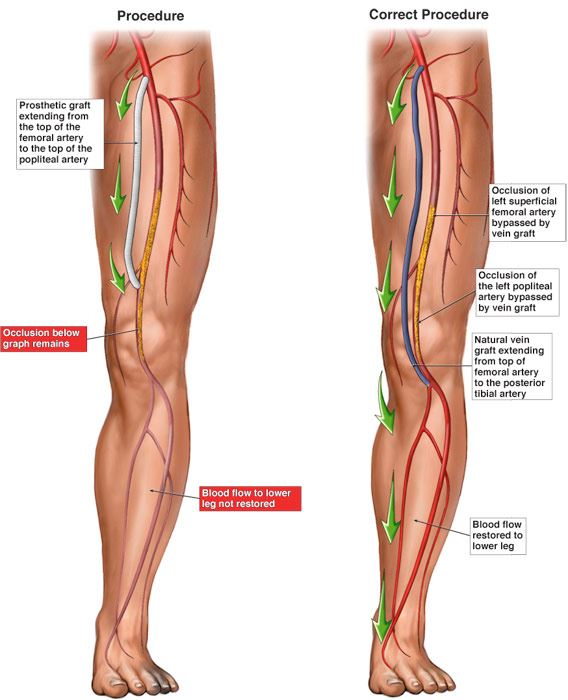Peripheral Vascular Bypass
A peripheral vascular bypass, also called a lower extremity bypass, is a minimally-invasive procedure (small incisions of 2-3 inches long / general anesthesia) performed to reroute blood flow around a blocked blood vessel (artery). It does so by creating a new pathway for blood flow using a synthetic graft (plastic tube) or your own vein.
The obstructed blood vessel is typically caused by peripheral artery disease (PAD). PAD occurs when plaque builds up on the walls of the arteries (atherosclerosis). This blockage reduces the normal flow of blood that carries oxygen and nutrients to the lower extremities. This causes cells and tissue in the legs and feet to die from lack of oxygen and nutrition. Normal growth and cell repair cannot take place, which can lead to gangrene in the limbs and subsequent amputation in the worst cases.
Peripheral vascular bypass is named for the artery that will be bypassed and the arteries that will receive the rerouted blood. The three common vascular bypass surgeries are: Aortobifemoral (reroutes blood from the abdominal aorta to the two femoral arteries in the groin), femoropopliteal (reroutes blood from the femoral to the popliteal arteries above or below the knee), and femorotibial (which reroutes blood between the femoral artery and the tibial artery).
The life of a surgical bypass depends on the health of your arteries, the type of graft used (natural last longer than synthetic), and other health factors such as whether you smoke, or have diabetes or kidney failure.
Do you have a question? Request more information and we will connect you with an RWJBarnabas Health cardiovascular expert.
How to Prepare for the Procedure
Before the procedure, your doctor and treatment team will explain to you what to expect before, during and after the procedure and potential risks of the procedure. Talk to your doctor about:
- All medications, herbal products and dietary supplements you are currently taking and ask for their recommendations about each.
- Any allergies to medicines, latex, tape, iodine, and anesthetic agents.
- Any history of bleeding disorders.
Other recommendations include:
- Leave all jewelry at home.
- Remove all makeup and nail polish.
- Wear comfortable clothing when you come to the hospital.
- If you normally wear dentures, glasses, or hearing devices at home, plan to wear them during the procedure.
What to Expect Before the Procedure
Before the procedure, your doctor may perform a variety of diagnostic tests, including:
What to Expect During the Procedure

A peripheral bypass surgery usually lasts 3 to 4 hours, but the preparation and recovery time may add several hours. The procedure is usually performed in the operating room (OR). Check with your doctor about the details of your procedure. In general:
- You will change into a hospital gown.
- A nurse will start the intravenous (IV) line in your arm which will administer medications, fluids, and also give you a sedative that will help you relax.
- Prior to starting the procedure, you will receive a local anesthetic. Once you are sedated, your doctor may insert a breathing tube through your throat into your lungs and connect you to a ventilator. This will breathe for you during surgery.
- You doctor may choose regional anesthesia instead of general anesthesia. Regional anesthesia is delivered through an epidural (in the back) to numb area operated on. While general anesthesia will make you feel sleepy. The doctor will determine which type of anesthesia is appropriate.
- The procedure begins when your doctor makes incisions in your leg. The site of the incision will depend on the section of the arteries to be bypassed.
- The doctor will determine whether to use a man-made graft or a vein from the leg to bypass the diseased artery.
- Once the graft is identified, your doctor will attach the graft onto the diseased artery.
- To verify that blood flow is flowing properly through the graft, an arteriogram (type of X-ray) may be performed.
- Once the procedure is complete, your incision will be closed with the use of a closure device or sutures.
What to Expect After the Procedure
After the procedure, you may be taken to the recovery room or intensive care unit (ICU) for further observation. Generally speaking, after this procedure, you’ll be able to go home within 2 to 4 days. Other recommendations include:
General Guidelines
- A nurse will monitor your vital signs, the insertion site, circulation, movement and sensation in the affected leg or arm.
- The incision may be tender or sore for several days after the procedure.
- Take a pain reliever as recommended by your doctor.
- You may be on special IV medicines to help your blood pressure and to control any problems with bleeding.
- At the appropriate time, you will be helped out of bed to walk around as you can handle it.
- Your doctor will give you instructions to follow during your recovery.
Do you have a question? Request more information and we will connect you with an RWJBarnabas Health cardiovascular expert.
